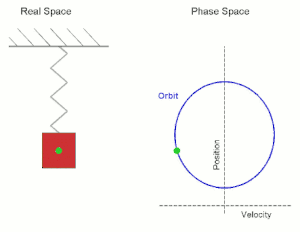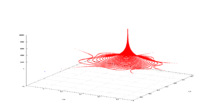Orbit (dynamics)
In mathematics, in the study of dynamical systems, an orbit is a collection of points related by the evolution function of the dynamical system. It can be understood as the subset of phase space covered by the trajectory of the dynamical system under a particular set of initial conditions, as the system evolves. As phase space trajectory is uniquely determined for any given set of phase space coordinates, it is not possible for different orbits to intersect in phase space, therefore the set of all orbits of a dynamical system is a partition of the phase space. Understanding the properties of orbits by using topological methods is one of the objectives of the modern theory of dynamical systems.
For discrete-time dynamical systems, the orbits are sequences; for real dynamical systems, the orbits are curves; and for holomorphic dynamical systems, the orbits are Riemann surfaces.
Definition

Given a dynamical system (T, M, Φ) with T a group, M a set and Φ the evolution function
- where with
we define
then the set
is called orbit through x. An orbit which consists of a single point is called constant orbit. A non-constant orbit is called closed or periodic if there exists a in such that
- .
Real dynamical system
Given a real dynamical system (R, M, Φ), I(x) is an open interval in the real numbers, that is . For any x in M
is called positive semi-orbit through x and
is called negative semi-orbit through x.
Discrete time dynamical system
For discrete time dynamical system :
forward orbit of x is a set :
backward orbit of x is a set :
and orbit of x is a set :
where :
- is an evolution function which is here an iterated function,
- set is dynamical space,
- is number of iteration, which is natural number and
- is initial state of system and
Usually different notation is used :
- is written as
- where is in the above notation.
General dynamical system
For a general dynamical system, especially in homogeneous dynamics, when one has a "nice" group acting on a probability space in a measure-preserving way, an orbit will be called periodic (or equivalently, closed) if the stabilizer is a lattice inside .
In addition, a related term is a bounded orbit, when the set is pre-compact inside .
The classification of orbits can lead to interesting questions with relations to other mathematical areas, for example the Oppenheim conjecture (proved by Margulis) and the Littlewood conjecture (partially proved by Lindenstrauss) are dealing with the question whether every bounded orbit of some natural action on the homogeneous space is indeed periodic one, this observation is due to Raghunathan and in different language due to Cassels and Swinnerton-Dyer . Such questions are intimately related to deep measure-classification theorems.
Notes
It is often the case that the evolution function can be understood to compose the elements of a group, in which case the group-theoretic orbits of the group action are the same thing as the dynamical orbits.
Examples

- The orbit of an equilibrium point is a constant orbit
Stability of orbits
A basic classification of orbits is
- constant orbits or fixed points
- periodic orbits
- non-constant and non-periodic orbits
An orbit can fail to be closed in two ways. It could be an asymptotically periodic orbit if it converges to a periodic orbit. Such orbits are not closed because they never truly repeat, but they become arbitrarily close to a repeating orbit. An orbit can also be chaotic. These orbits come arbitrarily close to the initial point, but fail to ever converge to a periodic orbit. They exhibit sensitive dependence on initial conditions, meaning that small differences in the initial value will cause large differences in future points of the orbit.
There are other properties of orbits that allow for different classifications. An orbit can be hyperbolic if nearby points approach or diverge from the orbit exponentially fast.
See also
- Wandering set
- Phase space method
- Cobweb plot or Verhulst diagram
- Periodic points of complex quadratic mappings and multiplier of orbit
- Orbit portrait
References
- Katok, Anatole; Hasselblatt, Boris (1996). Introduction to the modern theory of dynamical systems. Cambridge. ISBN 0-521-57557-5.
- Perko, Lawrence (2001). "Periodic Orbits, Limit Cycles and Separatrix Cycles". Differential Equations and Dynamical Systems (Third ed.). New York: Springer. pp. 202–211. ISBN 0-387-95116-4.